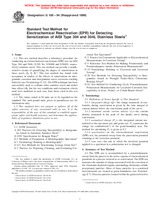We need your consent to use the individual data so that you can see information about your interests, among other things. Click "OK" to give your consent.
ASTM G108-94(1999)
Standard Test Method for Electrochemical Reactivation (EPR) for Detecting Sensitization of AISI Type 304 and 304L Stainless Steels
STANDARD published on 10.8.1999
The information about the standard:
Designation standards: ASTM G108-94(1999)
Note: WITHDRAWN
Publication date standards: 10.8.1999
SKU: NS-57252
The number of pages: 9
Approximate weight : 27 g (0.06 lbs)
Country: American technical standard
Category: Technical standards ASTM
Annotation of standard text ASTM G108-94(1999) :
Keywords:
Carbide precipitation, Corrosion-intergranular, Electrochemical measurements, Electrochemical reactivation (EPR) test, EPR test, Intergranular corrosion, Nondestructive evaluation (NDE), Potentiodynamic polarization, Sensitization, Stainless steel-corrosion testing, Stress corrosion cracking, electrochemical reactivation (EPR) test method-detecting sensitization, of AISI Type 304/304L stainless steels, laboratory test, ICS Number Code 77.140.20 (Steels of high quality)
Additional information
| 1. Scope | ||||||||||||||||||||||
|
1.1 This test method describes a laboratory procedure for conducting an electrochemical reactivation (EPR) test on AISI Type 304 and 304L (UNS No. S30400 and S30403, respectively) stainless steels. This test method can provide a nondestructive means of quantifying the degree of sensitization in these steels (1, 2, 3). This test method has found wide acceptance in studies of the effects of sensitization on intergranular corrosion and intergranular stress corrosion cracking behavior (see Terminology G15). The EPR technique has been successfully used to evaluate other stainless steels and nickel base alloys (4), but the test conditions and evaluation criteria used were modified in each case from those cited in this test method. 1.2 The values stated in SI units are to be regarded as the standard. The inch-pound units given in parentheses are for information only. 1.3 This standard does not purport to address all of the safety concerns, if any, associated with its use. It is the responsibility of the user of this standard to establish appropriate safety and health practices and determine the applicability of regulatory limitations prior to use. |
||||||||||||||||||||||
| 2. Referenced Documents | ||||||||||||||||||||||
|
We recommend:
Technical standards updating
Do you want to make sure you use only the valid technical standards?
We can offer you a solution which will provide you a monthly overview concerning the updating of standards which you use.
Would you like to know more? Look at this page.




 Cookies
Cookies
